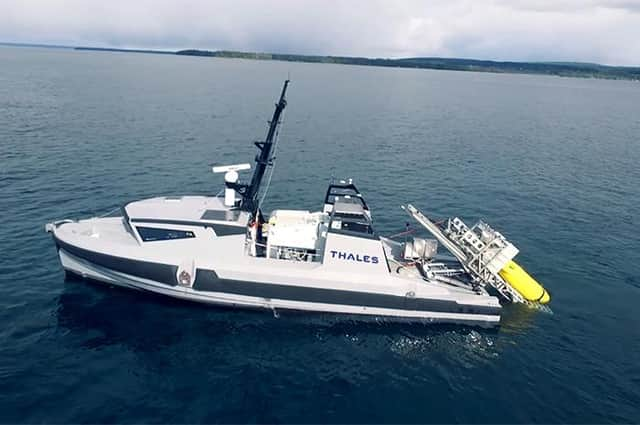Royal Navy takes charge of its first robotic minehunter set to revolutionise the fleet
This article contains affiliate links. We may earn a small commission on items purchased through this article, but that does not affect our editorial judgement.


The cutting-edge autonomous system, which will help secure tech jobs in Portsmouth, is built to detect and destroy modern mines.
Navy top brass have insisted the new robots will reduce the risk to naval divers, who are charged with disposing of underwater ordnance.
Advertisement
Hide AdAdvertisement
Hide AdThe remotely-operated boat, controlled from either a ship or land, tows a highly-sensitive detection device to combat sea mines, protecting personnel and ships from danger.
Commodore Steve Prest, deputy director navy acquisition within the Royal Navy, said the arrival of the new drone was exciting, adding: ‘The future of mine warfare is here.
‘The Royal Navy’s mine-hunting capability programme is real; it’s happening; it’s delivering. We have a lot to learn about this transformational approach to mine warfare, but there is much, much more to come.’
Made possible under the joint Maritime Mine Counter Measures (MMCM) programme between the UK and France, the system, has been produced by Thales UK and has undergone rigorous trials with navy.
Advertisement
Hide AdAdvertisement
Hide AdThe hi-tech gear will sit alongside other MMCM systems provided through an additional £184m investment, agreed last year, and supporting around 215 jobs in the UK.
As well as Thales UK sites in Somerset and Plymouth, jobs will be sustained in the wider supply chain at L3 Harris in Portsmouth and elsewhere.
Jeremy Quin, defence procurement minister, said: ‘This new technology is a huge leap forward for the Royal Navy’s autonomous capabilities in the detection of sea mines.
‘These systems will keep our personnel out of harm’s way whilst they conduct vital operations to protect shipping lanes from these hidden threats.
Advertisement
Hide AdAdvertisement
Hide Ad‘This is just one example of how we are putting innovation at the forefront of our future strategies.’
Sea mines constitute a growing threat and users of the system will be able to detect and neutralise mines from miles away, ensuring they can keep vital sea lanes open, with much-reduced risk to ships and the lives of sailors.
Made up of an uncrewed surface vessel, towed sonar and a portable operation centre, the new mine-hunting drones are designed to eventually replace crewed current minehunters, such as the navy’s Hunt and Sandown-class ships, with autonomous systems.
Looking for the latest Royal Navy updates from Portsmouth? Join our new Royal Navy news Facebook group to keep up to date.
A message from the Editor, Mark Waldron
You can subscribe here for unlimited access to our online coverage, including Pompey, with 70 per cent fewer adverts for less than 20p a day.
Comment Guidelines
National World encourages reader discussion on our stories. User feedback, insights and back-and-forth exchanges add a rich layer of context to reporting. Please review our Community Guidelines before commenting.
